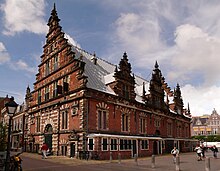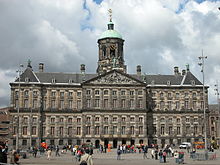| This article relies largely or entirely on a single source. Relevant discussion may be found on the talk page. Please help improve this article by introducing citations to additional sources. Find sources: "Architecture of the Netherlands" – news · newspapers · books · scholar · JSTOR (November 2018) |

Dutch architecture has played an important role in the international discourse on architecture in three eras. The first of these was during the 17th century, when the Dutch empire was at the height of its power. The second was in the first half of the 20th century, during development of modernism. The third is not concluded and involves many contemporary Dutch architects who are achieving global prestige.
Examples
 Southeast Asia
Dutch areas of Europe
Southern Africa
Caribbean, Curaçao
Malacca
Jakarta
Swellendam
Willemstad
Urk
Groningen
Guelders area
Holland
Southeast Asia
Dutch areas of Europe
Southern Africa
Caribbean, Curaçao
Malacca
Jakarta
Swellendam
Willemstad
Urk
Groningen
Guelders area
Hollandarea Apeldoorn Amsterdam The Hague Rotterdam Utrecht Willemstad Brussels Antwerp Breda 's-Hertogenbosch Eindhoven East Brabant
area Maastricht Ghent Bruges Courtrai Dunkirk
Renaissance and Baroque

The Dutch Golden Age roughly spanned the 17th century. Due to the thriving economy, cities expanded greatly. New town halls and storehouses were built, and many new canals were dug out in and around various cities such as Delft, Leiden, and Amsterdam for defense and transport purposes. Many wealthy merchants had new houses built along these canals. These houses were generally very narrow and had ornamented façades that befitted their new status. In the countryside, new country houses were built, though not in the same numbers.
Of Italian Renaissance architecture, primarily visual characteristics such as pillars, pilasters, pediments, and rustication were adopted, since many Dutch architects were unable to read the theoretical substantiation, which was often written down in Italian or Latin. Horizontal lines were emphasized, contrasting with the vertical emphasis of Gothic architecture. For instance, light-coloured bands were embedded into facades to emphasize this horizontal character. Another common application in Dutch Renaissance architecture, particularly in Amsterdam, was the stepped gable, which was meant to hide the diagonal lines of the gable behind the straight lines of the façade.
The architecture of the first republic in Northern Europe was marked by sobriety and restraint, and was meant to reflect democratic values by quoting extensively from classical antiquity. It found its impetus in the designs of Hendrick de Keyser, who was instrumental in establishing a Venetian-influenced style into early 17th-century architecture through new buildings like the Noorderkerk ("Northern church", 1620–1623) and Westerkerk ("Western church", 1620–1631) in Amsterdam. In general, architecture in the Low Countries, both in the Counter-Reformation-influenced south and Protestant-dominated north, remained strongly invested in northern Italian Renaissance and Mannerist forms that predated the Roman High Baroque style of Borromini and Bernini. Instead, the more austere form practiced in the Dutch Republic was well suited to major building patterns: palaces for the House of Orange and new civic buildings, uninfluenced by the Counter-Reformation style that made some headway in Antwerp.

The major exponents of the mid-17th century, Jacob van Campen and Pieter Post, adopted de Keyser's forms for such eclectic elements as giant-order pilasters, gable roofs, central pediments, and vigorous steeples. Brought together in a coherent combination, these stylistic developments anticipated Wren's Classicism. The most ambitious constructions of the period included the seats of self-government in Amsterdam (1646) and Maastricht (1658), designed by Campen and Post, respectively. On the other hand, the residences of the House of Orange are closer to a typical burgher mansion than to a royal palace. Two of these, Huis ten Bosch and Mauritshuis, are symmetrical blocks with large windows, stripped of ostentatious Baroque flourishes. The same austerely geometrical effect is achieved without great cost or pretentious effects at the stadholder's summer residence of Het Loo.
Another of the designs used by the Dutch was the use of warm colors such as red or dark orange. They also were roughly textured and had tended to be darkened due to the rough texturing. The use of architectural symmetrical balance was part of their habits as well.
Modernism

During the 20th century, Dutch architects like Berlage, Van Doesburg, Van Eesteren, Rietveld, Oud and Van der Vlugt played a leading role in the development of modern architecture in the Netherlands, as well as internationally.
Crucial for the development of modern architecture in the Netherlands has been the work of Hendrik Petrus Berlage, architect of the Beurs van Berlage. He propagated Rationalist architecture, while simultaneously embracing craftsmanship. Berlage has also received critical acclaim for Plan Zuid, an urban plan for Amsterdam-Zuid, which became a model for social housing developments in the Netherlands and abroad. Berlage inspired different movements, and different groups and schools were established accordingly, during the 1910s-1930s, each with their own view on which direction modern architecture should take.
- Expressionist architects like Michel de Klerk and Piet Kramer were associated with the Amsterdam School, a modern movement that emphasized the importance of craftsmanship. A direct relationship can be observed in Plan Zuid.
- Another group established De Stijl, based on the eponymous magazine (1917–1932). Prominents architects of this multidisciplinary artistic movement were J.J.P. Oud, Jan Wils, and Gerrit Rietveld. These architects would later build in a functionalist style.
- A third group, partly developing out of De Stijl, consisted of functionalist architects (Nieuwe Zakelijkheid or Nieuwe Bouwen), such as Mart Stam, Leendert van der Vlugt, and Johannes Duiker. Theye were part of the international modernist group CIAM. Berlage, however, criticized this movement for its lack of emotion. It was nevertheless very influential, also, and especially after WWII, in both architecture and town planning, through the work of, among other, Lotte Stam-Beese and Cornelis van Eesteren. Their work also informed planning theory and practice abroad.
- A more traditionalist current also developed out of Berlage's architecture, especially taking inspiration from its crafsmenship. This developed into the Traditionalist School, which included the Delftse School, headed by Marinus Jan Granpré Molière. Traditionalist architects rejected the main (industrial) principles of functionalism, and came to the fore in the 1930s. As a movement, traditionalist architecture lasted until well after 1945.
Several cross-connections existed between the schools and movements, as can be observed in the work of Willem Dudok; some of his designs have traditionalist features, while others are landmarks of functionalism. In the (late) 1930s, various modern architects advocated a return to (certain) traditional artistic principles, instead of following a machine aesthetics, among them J.J.P Oud and Sybold van Ravesteyn, although the reverse happened as well, especially in the 1950s-1960s (e.g. J.F. Berghoef). The different movements and schools, together with their disputes, would inform the development of Dutch architecture in the second half of the 20th century, which also witnessed the emergence of new (modern) movements, structuralism being an important one, with architects such as Aldo van Eyck, Herman Hertzberger, and Piet Blom.
Dutch colonial architecture
Main article: Dutch colonial architectureSee also
- Cape Dutch architecture
- Colonial architecture of Indonesia
- Dutch colonial architecture
- List of protected buildings in Sint Eustatius
References
- dianamuir. "Diana Muir Appelbaum » Blog Archive » Miracle of the Dutch Republic". Retrieved 14 December 2021.
- "Hollandse renaissance". architectenweb.nl (in Dutch). Retrieved 22 December 2014.
- "Pieter Post | Dutch architect | Britannica". Encyclopædia Britannica. Retrieved 14 December 2021.
- "Architect Hans van Heeswijk on The Pioneers of the Dutch Modern House". iconichouses.org. Retrieved 14 December 2021.
- Dijk, Hans van (1999). Twentieth-century Architecture in the Netherlands. 010 Publishers. ISBN 978-90-6450-347-4.
- Berlage, Hendrik Petrus (1 January 1996). Hendrik Petrus Berlage: Thoughts on Style, 1886-1909. Getty Publications. ISBN 978-0-89236-333-9.
- Stieber, Nancy (20 July 1998). Housing Design and Society in Amsterdam: Reconfiguring Urban Order and Identity, 1900-1920. University of Chicago Press. ISBN 978-0-226-77417-6.
- 明, 越沢 (1991). "アムステルダムの都市計画の歴史-1917年のベルラーへの南郊計画とアムステルダム派の意義". 土木史研究. 11: 155–166. doi:10.2208/journalhs1990.11.155.
- Rovinelli, H. Paul (1 October 1984). "H. P. Berlage and the Amsterdam School, 1914-1920: Rationalist as Expressionist". Journal of the Society of Architectural Historians. 43 (3): 256–264. doi:10.2307/990006. ISSN 0037-9808. JSTOR 990006.
- Doorman, Maarten; Marx, Sherry (2003), "Innovation in Painting and Architecture: De Stijl", Art in Progress, A Philosophical Response to the End of the Avant-Garde, Amsterdam University Press, pp. 81–114, ISBN 978-90-5356-585-8, JSTOR j.ctt46mz0k.9, retrieved 18 December 2023
- Grüttemeier, Ralf; Beekman, Klaus Detlef; Rebel, Ben (2013). Neue Sachlichkeit and avant-garde. Amsterdam: Rodopi. ISBN 978-90-420-3640-6.
- Grüttemeier, Ralf; Beekman, Klaus Detlef; Rebel, Ben (2013). Neue Sachlichkeit and avant-garde. Amsterdam: Rodopi. ISBN 978-90-420-3640-6.
- Koningsberger, Victorien (2012). Verslag Van eesterengesprek #13: Architect J.F. Berghoef 'Traditionalist of modernist?' (in Dutch). Amsterdam: Van Eesteren Museum.
- Searing, Helen (1981). "Review of S. van Ravesteyn; Auke Komter/architect". Journal of the Society of Architectural Historians. 40 (2): 159–161. doi:10.2307/989746. ISSN 0037-9808. JSTOR 989746.
External links
- Architectureguide.nl, Online guide to Modern Architecture in The Netherlands
| Architecture of Europe | |
|---|---|
| Sovereign states |
|
| States with limited recognition | |
| Dependencies and other territories | |
| History | |